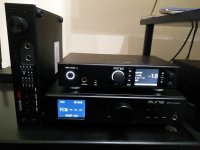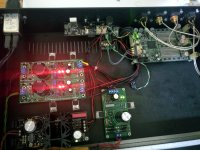Will this work for 5V shunt too Salas?The orange ones (WP2773ND) look like having close Vf to the reds, also a steeper curve which is a good thing. Orange glow is nice to the eye as well.
Okay,
Here are some measurements for both mouser and element14 parts.
These are taken at 9.1V with a 1K resistor in series. 9V used for battery and 1k common part. Measured for 1 second at below room temperature.
Via Mouser
WP2773ND (orange)
1.88v average
WP2773ID (legacy Red)
1.85v average
WP-144SRDT
1.73v average
WP-113SRDT
1.73v average
Element14
L-383SRDT
1.74v average
L-144IDT
1.85v average
Vishay RHR4400
1.88v average
I am thinking if hovering low voltage for UBIB, we want to be on the lower side, than the SRDT models from kingbright are the way to go here. you may have better luck with element14 where you are for shipping, but who knows. Mouser seems to carry more parts, at least in North America.
Here are some measurements for both mouser and element14 parts.
These are taken at 9.1V with a 1K resistor in series. 9V used for battery and 1k common part. Measured for 1 second at below room temperature.
Via Mouser
WP2773ND (orange)
1.88v average
WP2773ID (legacy Red)
1.85v average
WP-144SRDT
1.73v average
WP-113SRDT
1.73v average
Element14
L-383SRDT
1.74v average
L-144IDT
1.85v average
Vishay RHR4400
1.88v average
I am thinking if hovering low voltage for UBIB, we want to be on the lower side, than the SRDT models from kingbright are the way to go here. you may have better luck with element14 where you are for shipping, but who knows. Mouser seems to carry more parts, at least in North America.
Okay,
Here are some measurements for both mouser and element14 parts.
These are taken at 9.1V with a 1K resistor in series. 9V used for battery and 1k common part. Measured for 1 second at below room temperature.
Via Mouser
WP2773ND (orange)
1.88v average
WP2773ID (legacy Red)
1.85v average
WP-144SRDT
1.73v average
WP-113SRDT
1.73v average
Element14
L-383SRDT
1.74v average
L-144IDT
1.85v average
Vishay RHR4400
1.88v average
I am thinking if hovering low voltage for UBIB, we want to be on the lower side, than the SRDT models from kingbright are the way to go here. you may have better luck with element14 where you are for shipping, but who knows. Mouser seems to carry more parts, at least in North America.
You measured for about 7mA change your 1K to 3.3K so to measure at near 2mA which is the average current that the LEDS run in the UBiB
So this trends us down expectedly on voltage
Via Mouser
WP2773ND (orange)
1.77v average
WP2773ID (legacy Red)
1.73v average
WP-144SRDT
1.67v average
WP-113SRDT
1.675v average
Element14
L-383SRDT
1.67v average
L-144IDT
1.725 average
Vishay RHR4400
1.73v average
Just want to make sure these are all good recommended alternatives for LEDs for 5V
Will this work for 5V shunt too Salas?
Yep
All those you listed between 1.725V and 1.77V at 2mA are good replacements
SRDT are a too low and not good? These are the ones kingbright lists as 1.85vF vs 2v.
So this trends us down expectedly on voltage
Via Mouser
WP2773ND (orange)
1.77v average
WP2773ID (legacy Red)
1.73v average
WP-144SRDT
1.67v average
WP-113SRDT
1.675v average
Element14
L-383SRDT
1.67v average
L-144IDT
1.725 average
Vishay RHR4400
1.73v average
Just want to make sure these are all good recommended alternatives for LEDs for 5V
Thanks Tea and Salas. This is definitely useful for anyone looking for the alternatives. Looks like the Vishay RHR4400 is the way to go as although the orange WP2773ND at the borderline is tempting for its color. ;-)
SRDT are a too low and not good? These are the ones kingbright lists as 1.85vF vs 2v.
That is at 20mA. They will basically work for us at 2mA also but they have somewhat shallower IF/VF curve at low mA than our legacy red (someone's bought Mouser's full WP2773ID stock during Christmas). Closer to it is the orange version. We wouldn't care much for such details for the whole voltage output range but at circa 5Vout its the two LEDS and the two transistors (Q2,Q3 Vbe) which are the main Vref contributors. An interesting type is the Vishay TLDR4400 deep red round one (Mouser) which has low Vf again but very steep curve at low mA in its datasheet. I hope its chemistry isn't more noisy than other reds for some reason.
He has gone to a better place. We all miss him.OT
where is AndrewT, I don't read anything of him by long time.
Salas, is it theoretically harmful to have additional aluminum electrolytic filter caps right after the DC output with maybe 20cm of wiring? Dam1021 has a few 1000uf Panasonic caps I believe on the input rails for handling AC input (after a now useless low noise bridge rectifier...), and I was wondering if it's bad since there're some serious guidelines on C3 choice.
The system sounds great now, especially after some more vref caps. Very natural sounding. Though I only have memory of the adapted sigma22 PSU from last year, I do believe UltraBiB removed quite a bit of harshness from the sound, if nothing else. Thanks again Salas!
The system sounds great now, especially after some more vref caps. Very natural sounding. Though I only have memory of the adapted sigma22 PSU from last year, I do believe UltraBiB removed quite a bit of harshness from the sound, if nothing else. Thanks again Salas!
Last edited:
Not harmful to have remote caps, I had tested for that during the development. Does not mean that they help your optimum sound or not though. You should compare with or without them sometime. The C3 guidelines are sensitive for the local termination node, after few cm of cable it starts becoming indifferent to various extras.
Nice to know you got nice results. I do try various dacs from time to time to follow where the technology is going. The dam belongs in the nice category. More delicate sound for natural timbre by the ladder, maybe not as present as ΔΣ. Here are few with AKM or ESS I was comparing during the weekend
Nice to know you got nice results. I do try various dacs from time to time to follow where the technology is going. The dam belongs in the nice category. More delicate sound for natural timbre by the ladder, maybe not as present as ΔΣ. Here are few with AKM or ESS I was comparing during the weekend
Attachments
I am just ordering the R1 resistors for the DAM 1121. The user manual has the typical and max current values. Which one should base off and add the CCS to?
You would want to cover the max values and then add some spare I would believe. Unless those max are for running in modes you most likely wouldn't evoke? Better verify with Dam experts in their threads (?)
Not harmful to have remote caps, I had tested for that during the development. Does not mean that they help your optimum sound or not though. You should compare with or without them sometime. The C3 guidelines are sensitive for the local termination node, after few cm of cable it starts becoming indifferent to various extras.
Nice to know you got nice results. I do try various dacs from time to time to follow where the technology is going. The dam belongs in the nice category. More delicate sound for natural timbre by the ladder, maybe not as present as ΣΔ. Here are few with AKM or ESS I was comparing during the weekend
If it's not significantly inferior in theory then it's more or less fine by me for now. It's kind of difficult and perhaps a bit risky for me to A/B between the caps especially when the boards are stacked with almost inseparable pin/pin headers... Good to get confirmation from someone experienced that I'm doing something terribly wrong.
The sound is natural and detailed by my ears. Don't have state-of-the-art sigma-delta to compare with though
You would want to cover the max values and then add some spare I would believe. Unless those max are for running in modes you most likely wouldn't evoke? Better verify with Dam experts in their threads (?)
For dam1021 Soren did state 50% extra for peak, so I would assume similar for 1121 - there should be something in the thread. But I'm not sure if it's just out of convention. If it helps, I run dual-mono with UltraBiB at 9V and it's about 45-50C (definitely not much higher but hard to get the exact number as the MOSFETs are buried under a bunch of wires in my build or just really hard to reach / hit accurately with IR lasers). Sinked with the bottom chassis and measures ~40C.
Btw what do you think of the 4V vref circuit in Soekris?... Is it plausible that vref capacitance was lacking? (3*100uF + 47uF MLCC) I heard a huge difference after I added 3*1500uF polymer caps per rail - much fuller low end and more naturalness/dynamics all-round. Even my noisy laptop soundcard is now more "analytical" than dam1021, though of course lacking in real low-level details.
Last edited:
The sound is natural and detailed by my ears. Don't have state-of-the-art sigma-delta to compare with thoughJust curious, what kind of vref caps were there on the build you tested? And what would be a good test of presence?... Always nice to pick up some audio knowledge especially from a trusty source

It was Dimdim's build, I did not ask him. Is this picture from post #14 of any help?
A good test for presence would be something like this: McCoy Tyner Quartet - Ask Me Now
Attachments
It was Dimdim's build, I did not ask him. Is this picture from post #14 of any help?
Looks like rev2 with 470uF polymer cap added to each rail. I think rev2 comes with 47uF each rail out of the box. Spikestabber recently added caps to his rev2 (or maybe rev1) and had great subjective results. Maybe Dimdim would be interested in trying the mod
The filter caps I was worried about are the 4 at the top left corner. I think the 2 to the right are for 5V LDO and another RC filter so probably has their place on the board... Anyways, will probably leave them there as is since they don't interfere with UltraBiB
Last edited:
- Home
- Amplifiers
- Power Supplies
- Salas SSLV1.3 UltraBiB shunt regulator

